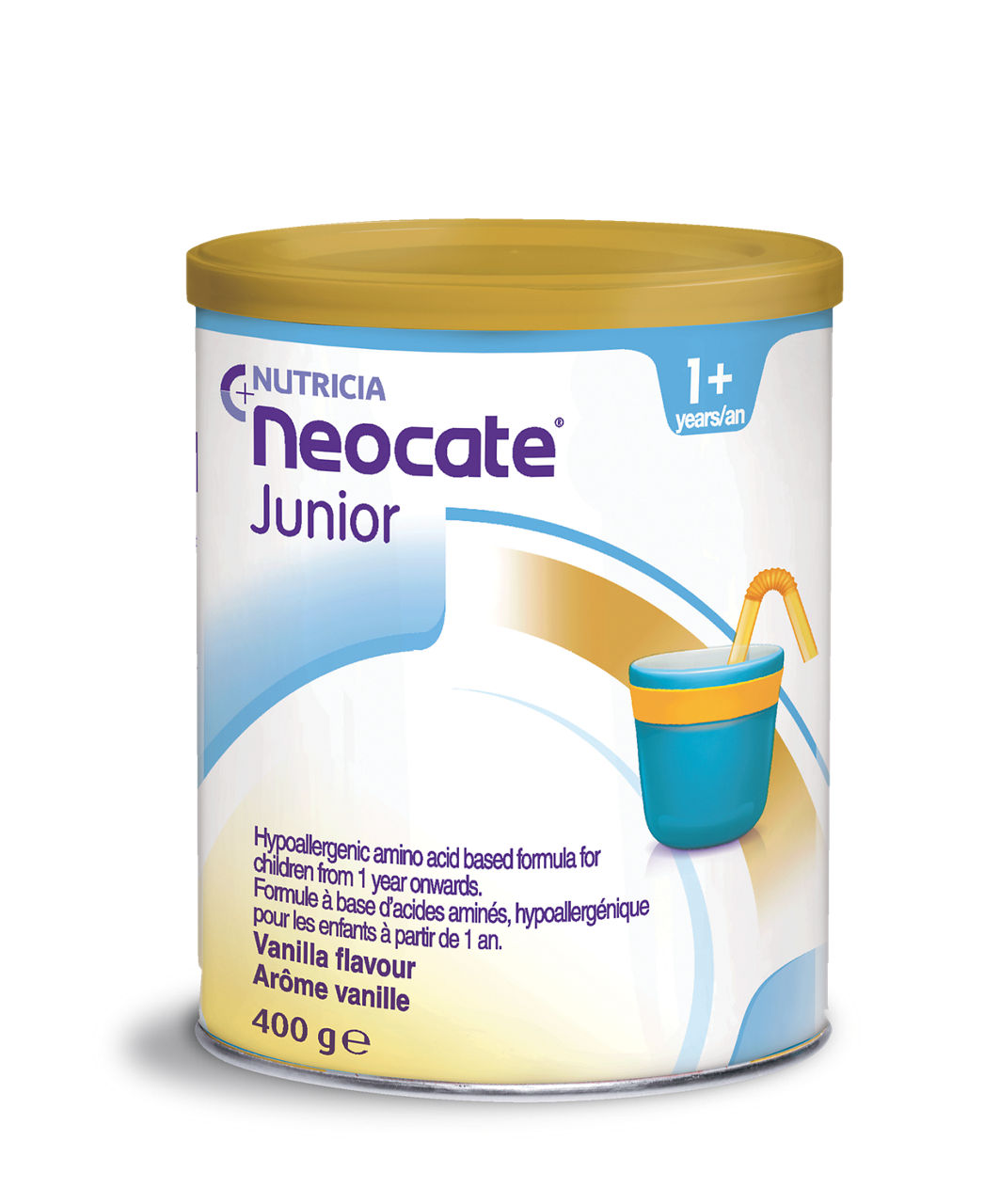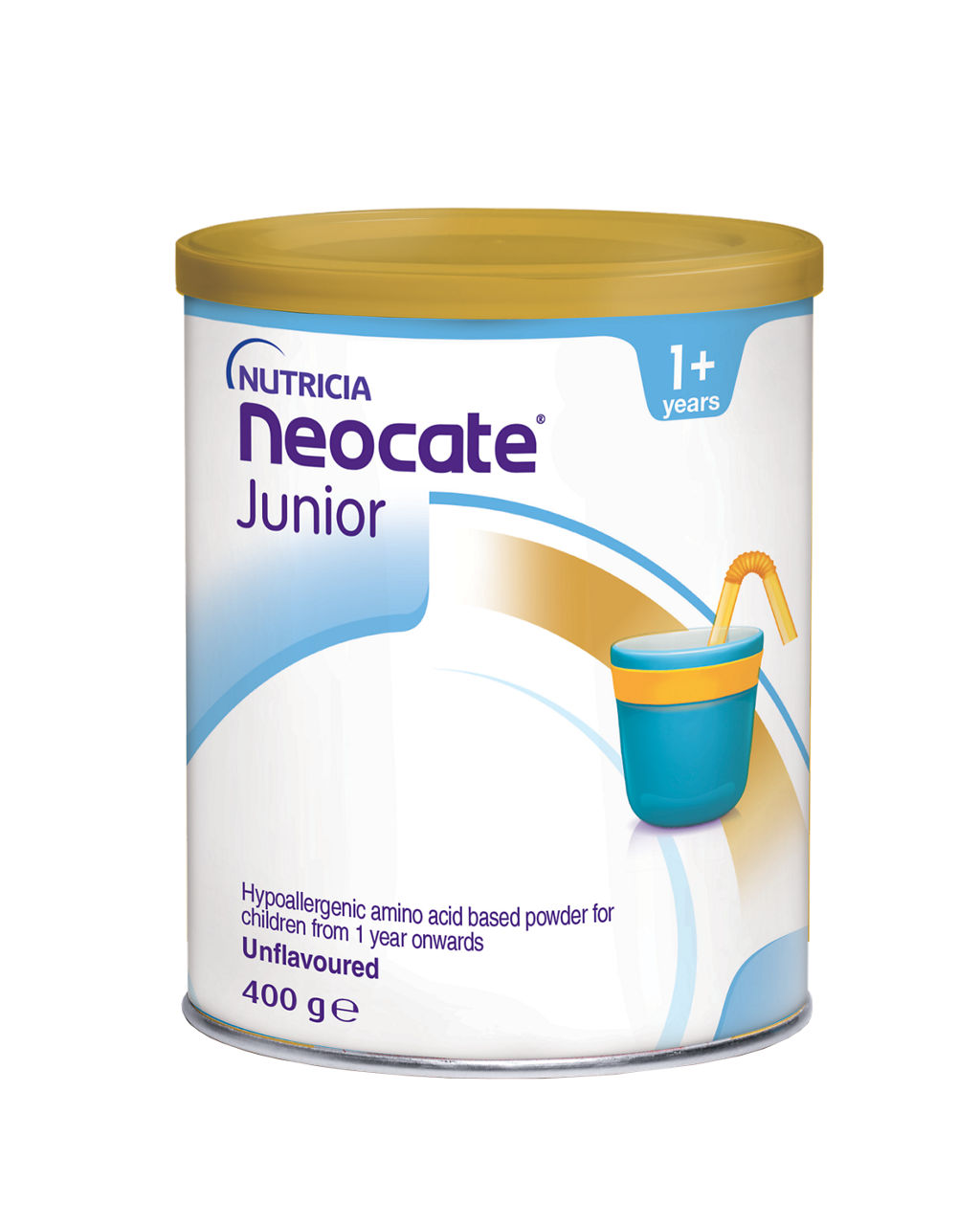Neocate Junior: 12+ months

Ready for their next step
For some children, Cow's Milk Allergy may persist beyond infancy into childhood. As children get older, their energy, protein, vitamin and mineral requirements change. Your Doctor or Dietitian may have prescribed Neocate Junior to help ensure that your child continues to get the nutrition they need. Below you can find out more information about the product your child has been prescribed and how to prepare it.
What is Neocate Junior and who is it for?
Neocate Junior is an amino acid-based, hypoallergenic formula specifically designed for use in the dietary management of children from 1 year of age with Cow’s Milk Allergy (CMA), Multiple Food Protein Allergies (MFPA) or other indications that require an amino-acid based formula.
Neocate Junior does not contain any cow’s milk protein and it is manufactured in a cow’s milk-free environment and packaged in a protective atmosphere to provide a high quality product.
Neocate Junior can be used to fully meet your child’s nutritional requirements or to provide additional nutrients to support a restricted diet.
Neocate Junior is available in Unflavoured, Strawberry and Vanilla flavours. Please speak to your healthcare professional for more information.
Neocate Junior is for children who are:
- 1 year of age or older and
- Require a hypoallergenic formula because of a diagnosis of Cow’s Milk Allergy, Multiple Food Protein Allergies, or another condition where an amino acid-based formula is indicated.
Preparation guidelines
- Wash your hands and clean the preparation area
- Use clean equipment to prepare the feed. Always use the scoop provided in the tin.
- Measure the required amount of warm or cool water into a container. Please note: Neocate Junior is best served chilled.
- Add the prescribed number of scoops of Neocate Junior into the water. The scoop provided holds 7.3g of Neocate Junior.
- Cover and shake or whisk until the powder has been dissolved.
- Once prepared, refrigerate and consume within 24 hours.
- Any formula remaining in the container after one hour of feeding should be discarded*.
- Shake or stir the feed immediately before serving.
*If your child is tube fed, Neocate Junior can hang for a maximum of 4 hours.
Each level scoop (7.3g powder) requires 30ml (approximately 1fl.oz) water to achieve the recommended standard dilution:
Number of scoops (weight of powder) | Amount of water | Approximate final volume |
| 1 (7.3g) | 30ml | 35ml |
| 3 (21.9g) | 90ml | 105ml |
| 10 (73g) | 300ml | 350ml |
Helpful hints and tips
Introduce Neocate Junior as soon as possible after it has been prescribed.
If your child is currently taking another formula, you can introduce Neocate Junior gradually alongside the other formula.
Neocate Junior can be added to certain foods and recipes; however, you should always follow your Doctor or Dietitian’s advice before introducing a new food into your child’s diet.
Neocate Junior can be offered in a beaker, bottle, cup or as a tube feed.
Be careful not to boil prepared Neocate Junior as this may affect the vitamin & mineral levels in the formula. Do not use a microwave oven to prepare or warm formula.
What to expect when first using Neocate Junior
Neocate Junior has a great taste and is available in three different flavours (Unflavoured, Vanilla and Strawberry) but it does taste different to other formulas, including amino acid-based infant formulas such as Neocate LCP.
If in the first few weeks after transitioning over you notice that your child starts drinking larger amounts of Neocate Junior compared to their previous formula, this is a good sign, indicating that your child accepts the new formula.
Follow your Doctor or Dietitian’s advice on how much Neocate Junior to feed your child each day.
Transitioning your child from their current formula to Neocate Junior
While many children will tolerate a direct switch from their current formula to Neocate Junior, some sensitive children may need to be transitioned more slowly onto Neocate Junior. This gradual transition can be achieved by mixing Neocate Junior with your child’s usual formula. An example of a step by step transition is:
Day 1-3
Make up your child’s usual formula to 3/4 (75%) of what they should take in that feed. Then make up the remaining 1/4 (25%) of the feed with Neocate Junior. Repeat this for each feed for three days.
Day 4-6
Make up 1/2 (50%) of the required amount of their usual formula, and the remaining 1/2 (50%) of the feed with Neocate Junior. Repeat this for each feed for three days.
Day 7-9
Make up 1/4 (25%) of the required amount of their current formula, and the remaining 3/4 (75%) with Neocate Junior. Repeat this for each feed for three days.
Day 10-12
If tolerated, mix up the full recommended amount of feed with Neocate Junior. If your child does not accept the increasing amount of Neocate Junior during the transition period, reduce the amount of Neocate Junior to the amount provided on the previous day, and increase the amount more gradually until accepted.

